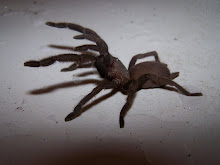Best of Youtube #4: Bacillus thurigiensis
Bruce Tabashnik explaining how B. thurigiensis is used to kill insects.
B. thurigiensis is kind of a cool bacteria. It's found on plants and in the soil and it's evolved to cover it's spores in a highly toxic protein that dissolves the gut of the poor insect that happens to eat it. Once the insect is dead, the bacteria can feast to their heart's content until the food supply runs out. At this point they form spores and the cycle starts over again. Each strain is adapted to different species of insects. There's a few different strains which go after butterfly, moth and beetle larvae and even one that infects parasitic flies. Each strain has it's own very narrow host range and none effect humans.
Many crops, corn and cotton to name two, have been genetically modified to produce this toxin within it's tissues. However, some have evolved resistance to the toxin. Fortunately, the mutations which grant resistance to BT have so far been recessive alleles and easily controlled by introducing susceptible variants to spread their genes amongst the immune genotypes.
Labels: Best of Youtube, Entomology


0 Comments:
Post a Comment
Subscribe to Post Comments [Atom]
<< Home